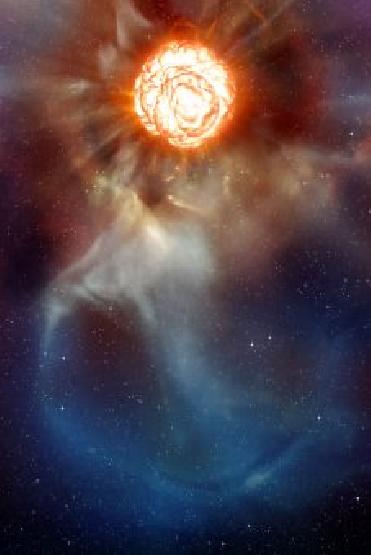
An artist's impression of the supergiant star Betelgeuse. -- Image credit: ESO
PARIS (BNS): Two teams of astronomers, using ESO�s Very Large Telescope (VLT), have obtained sharpest images of gigantic star Betelgeuse in the Orion constellation.
The red supergiant Betelgeuse is the second largest star in the constellation, almost 1,000 times bigger than the Sun. It is also one of the most luminous stars known, emitting an amount of light higher than those radiated by 100 000 Suns.
�Such extreme properties foretell the demise of a short-lived stellar king. With an age of only a few million years, Betelgeuse is already nearing the end of its life and is soon doomed to explode as a supernova,� the European Organisation for Astronomical Research in the Southern Hemisphere (ESO) said in a media release here on Wednesday.
The images of the giant star show that it has a vast plume of gas almost as large as our Solar System and a gigantic bubble boiling on its surface. These discoveries provide important clues to help explain how these mammoths shed material at such a tremendous rate, the ESO said.
Red supergiants hold several unsolved mysteries. One of them is how these behemoths shed such tremendous quantities of material � about the mass of the Sun � in only 10,000 years.
The new images of the colossal star are likely to shed light on mass-loss question of the stars.
�Thanks to these outstanding images, we have detected a large plume of gas extending into space from the surface of Betelgeuse,� said Pierre Kervella from the Paris Observatory, who led the team. The plume spreads to at least six times the diameter of the star, corresponding to the distance between the Sun and Neptune.
�This is a clear indication that the whole outer shell of the star is not shedding matter evenly in all directions,� Kervella said. Two mechanisms could explain this asymmetry � one assumes that the mass loss occurs above the polar caps of the giant star, possibly because of its rotation; the other possibility is that such a plume is generated above large-scale gas motions inside the star, known as convection � similar to the circulation of water heated in a pot.
To arrive at a solution, astronomers needed to probe the behemoth in finer detail for which they used �interferometry�. With the AMBER instrument on the VLT�s Interferometer, which combines light from three 1.8-metre auxiliary telescopes of the VLT, the scientists obtained observations as sharp as those of a giant, virtual 48-metre telescope.
�Our AMBER observations are the sharpest observations of any kind ever made of Betelgeuse. Moreover, we detected how the gas is moving in different areas of Betelgeuse�s surface � the first time this has been done for a star other than the Sun�, said Keiichi Ohnaka from the Max Planck Institute for Radio Astronomy in Bonn, Germany.
The observations revealed that the gas in Betelgeuse's atmosphere is moving vigorously up and down, and that these bubbles are as large as the supergiant star itself. The findings have led the astronomers to propose that these large-scale gas motions roiling under the mammoth star�s red surface are behind the ejection of the massive plume into space.
 Previous Article
Previous Article Next Article
Next Article













The Indian Air Force, in its flight trials evaluation report submitted before the Defence Ministry l..
view articleAn insight into the Medium Multi-Role Combat Aircraft competition...
view articleSky enthusiasts can now spot the International Space Station (ISS) commanded by Indian-American astr..
view article